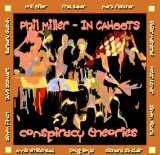Home » Jazz Articles » Album Review » Phil Miller - In Cahoots: Conspiracy Theories
Phil Miller - In Cahoots: Conspiracy Theories
The chemistry behind this band's presence on Conspiracy Theories is firmly rooted within sinuously enacted unison lines, featuring horns, keys and Miller's resonating single note licks. Longtime band-mates Pete Lemer and Fred Baker, on keyboard and bass respectively, help provide a fertile undercurrent for the addition of several highly respected British hornists, who expand the group's overall design. Yet the gist behind this outing resides within the layered horns and off-kilter shifts in strategy, where dynamics and heated improvisational exercises project a cohesive maxim. Lyrically rich solos by trombonist Annie Whitehead and tenor saxophonist Simon Picard often complement the band's surging opuses as melody plays an important role in Miller's compositional guiding principles.
Baker's "End Of The Line merges a dream-laden soundscape with Didier Malherbe's (of Gong) ethereal lines, zealously counterbalanced by Lemer's fuzz-toned electric piano phrasings and Miller's gliding, sustain-drenched notes. It's a ballad augmented by an ominous disposition and lucid imagery—perhaps a dad teaching his sibling about the rigors of youth and learning comes to mind.
On "Orinaca (anagram for Ocarina), Malherbe renders a poignant ocarina motif, contrasted by Miller's low-key and bluesy progressions, which segue into a catchy, world-music vibe. Ultimately, Miller's notable sense of diversity is uncannily cycled into a singular group sound that melds the fabled hierarchy of 1970s Canterbury stylizations with a modernist groove. And that alone speaks massive volumes.
With his latest incarnation of In Cahoots, Miller furthers the scope and sound of the preexisting factors that have placed this unit at the pinnacle of the jazz-rock realm. No doubt, this album should find its way onto upcoming top ten lists for 2007. Miller glowingly separates the listless wannabes and copycats from the proven warriors, largely transmitted with fluid power and a thrusting impetus.
Track Listing
Conspiracy Theories; Press Find Enter; Flashpoint; 5's and 7's; End of the Line; Freudian Triode; Orinaca; Crackpot; Lydiotic.
Personnel
Phil Miller
guitarPhil Miller: guitar and synth guitar; Pete Lemer: keyboards; Fred Baker: bass; Mark Fletcher: drums; Simon Picard: tenor sax; Simon Finch: trumpet, flugelhorn; Annie Whitehead: trombone; Didier Malherbe: soprano sax, flute, doudouk, ocarina; Doug Boyle: guitar; Dave Stewart: tuned percussion; Richard Sinclair: bass.
Album information
Title: Conspiracy Theories | Year Released: 2007 | Record Label: Moonjune Records
< Previous
Ottawa Jazz Festival Day 2: June 22, ...
Next >
Jazz at Prague Castle 2006
Comments
Tags
For the Love of Jazz
 All About Jazz has been a pillar of jazz since 1995, championing it as an art form and, more importantly, supporting the musicians who create it. Our enduring commitment has made "AAJ" one of the most culturally important websites of its kind, read by hundreds of thousands of fans, musicians and industry figures every month.
All About Jazz has been a pillar of jazz since 1995, championing it as an art form and, more importantly, supporting the musicians who create it. Our enduring commitment has made "AAJ" one of the most culturally important websites of its kind, read by hundreds of thousands of fans, musicians and industry figures every month.




















